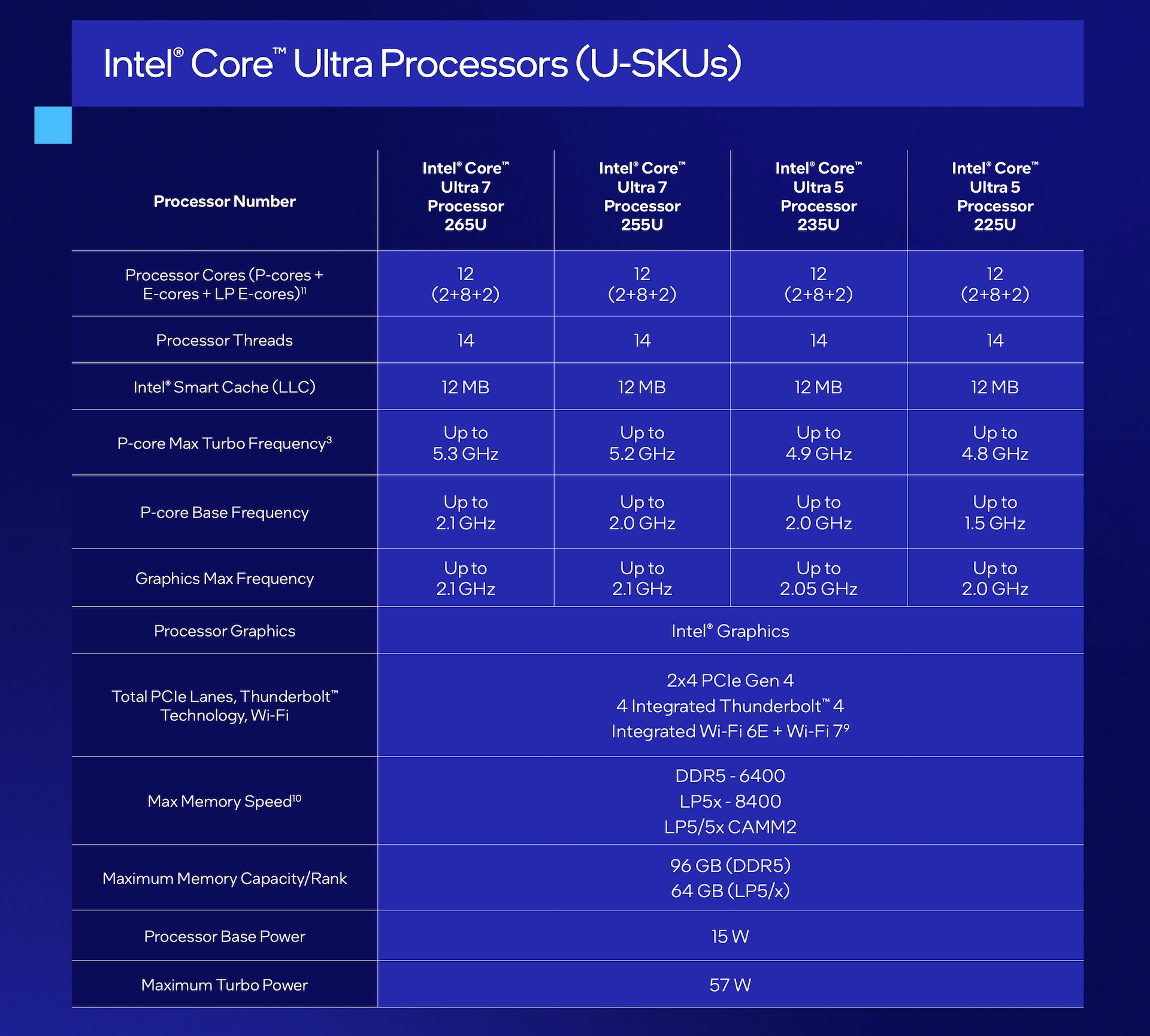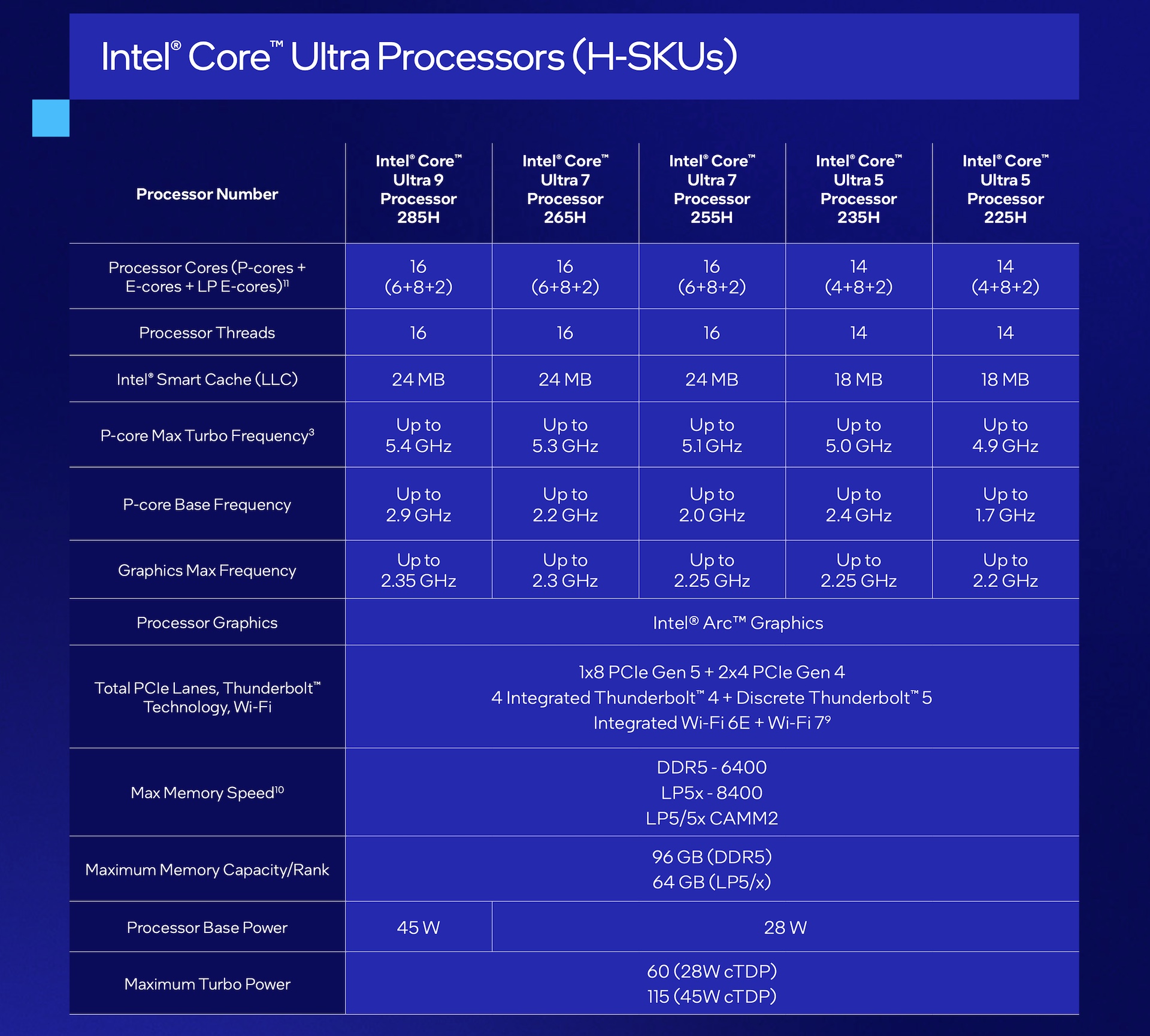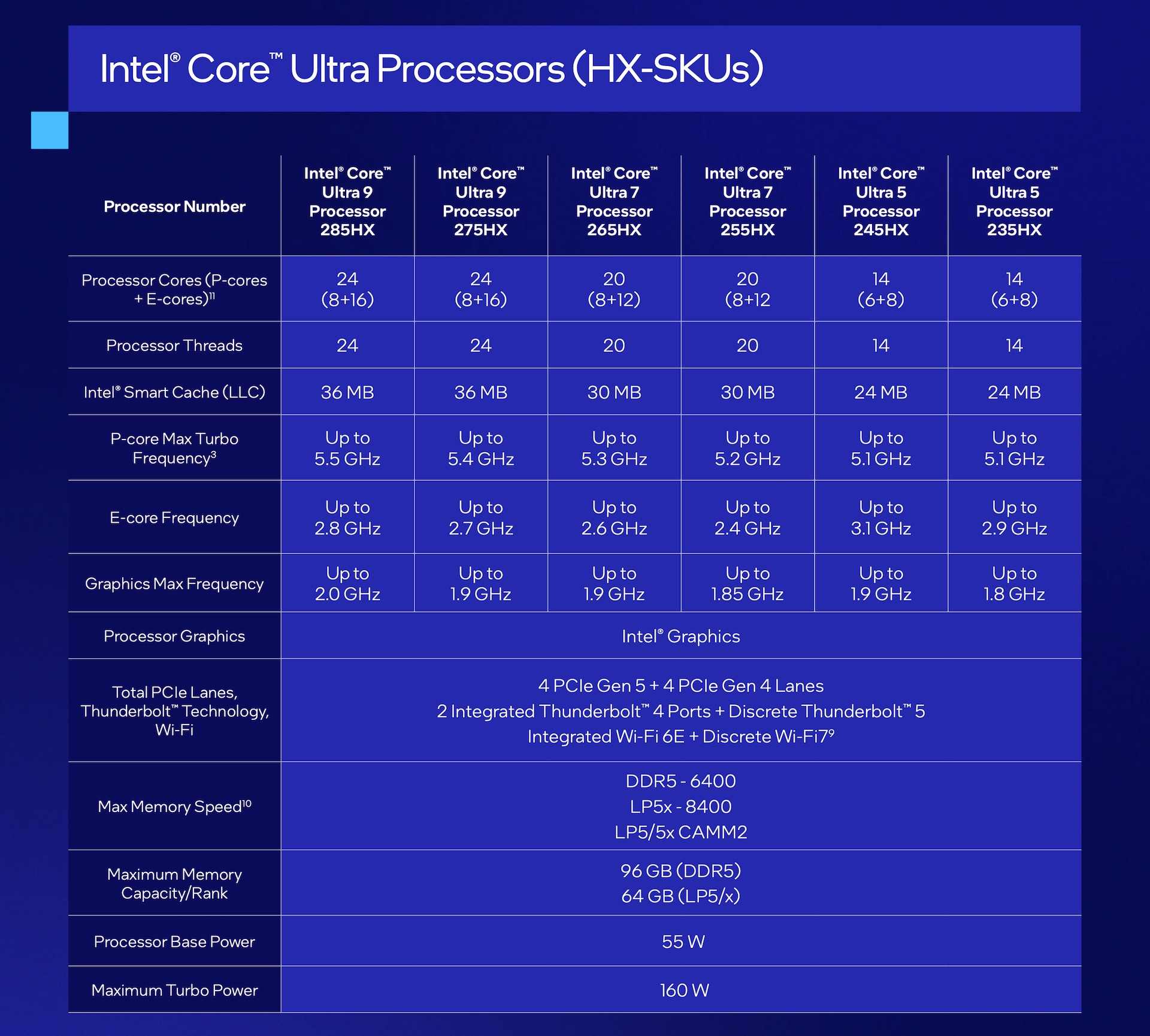Core Ultra 200U, 200H, and 200HX will all fall short of Copilot+ compatibility.

The new additions to the Core Ultra 200-series lineup today are in the U- and H-series, which Intel slots in below and above existing Lunar Lake-based Core Ultra 200V CPUs. HX-series CPUs also bring Intel’s desktop silicon to high-powered laptops. Credit: Intel
Intel’s Core Ultra 200 series is currently bifurcated between two architectures: Lunar Lake, which powers the Core Ultra 200V series of laptop chips; and Arrow Lake, which is included in the Core Ultra 200S desktop processors. Arrow Lake processors can include many more CPU cores, but only Lunar Lake uses Intel’s latest GPU architecture and a neural processing unit (NPU) fast enough for Microsoft’s Copilot+ functionality.
Intel is rounding out the rest of the Core Ultra 200 family today at CES, and the most important thing to know is that it’s Arrow Lake, and not Lunar Lake, that is powering all of these new processors (though with a major caveat for 200U series chips, more on that in a bit).
This means that none of them are fast enough to earn the Copilot+ label or use upcoming features like Windows Recall, and none of them will have integrated graphics that are as good as the Core Ultra 200V. But it will make them a better fit for gaming laptops and other kinds of systems that prioritize CPU performance or include an external graphics card, as well as less-expensive ultraportable laptops.
Intel may be going with Arrow Lake because Lunar Lake processors are more expensive to make; Intel’s (now former) CEO, Pat Gelsinger, declared the Lunar Lake design a “one-off” because of the extra cost associated with integrating the RAM into the CPU package. Intel said at the time that this saved motherboard space and reduced energy use, but these benefits aren’t being extended to the rest of the lineup.
Ars Video
How The Callisto Protocol’s Gameplay Was Perfected Months Before Release
Regardless of the reasoning, here’s what’s going on with the rest of Intel’s laptop chips this year.
Mixing and matching chiplets
All of Intel’s Core Ultra CPUs have used chiplet-based designs, which means that every processor die is actually a collection of smaller silicon tiles fused together with a “base tile” that facilitates communication between the chiplets. That’s relevant because it allows Intel to do some mixing and matching of different parts.
For example, the “Arrow Lake” of the Core Ultra U is totally different from all the other Arrow Lake CPUs in the lineup. Intel confirmed to Ars that the U-series processors actually use the older Redwood Cove P-core and Crestmont E-core architectures from the Meteor Lake-based Core Ultra 100 series, but the compute tile is made using an Intel 3 manufacturing process rather than the Intel 4 process that Meteor Lake used.
Both the U and H processors also appear to include an “SoC tile” similar or identical to the one used in Meteor Lake chips, giving them each a pair of extra low-power E-cores (or LP-E-cores) to handle low-lift or background tasks while consuming less energy than the standard E-cores. This was an approach Intel abandoned for Lunar Lake and also didn’t see fit to include in the desktop-class Arrow Lake CPUs.
Reusing or adapting Meteor Lake’s SoC tile would also explain why Core Ultra 200H and 200U processors have I/O capabilities identical to Meteor Lake’s—the same number of PCIe lanes, the same number of USB and SATA ports, and the same built-in support for Wi-Fi 6E and Wi-Fi 7. They also share the same 11 TOPS NPU as Meteor Lake and the same 96GB maximum memory capacity. We’re checking with Intel to see whether this is the same SoC tile used in Meteor Lake or if it’s been updated at all for Arrow Lake (with the new Skymont E-core architecture, for example).
U- and H-series: For thin-and-light laptops
Starting with the least powerful of the new CPUs: the Core Ultra 200U chips are made for thin-and-light systems, and on paper they’ve got competent but modest specifications. All four of the models Intel is announcing have two Redwood Cove P-cores, eight Crestmont E-cores, and the two LP-E cores. There’s also a GPU based on the last-generation Alchemist architecture, with a maximum of four cores (Intel’s specs don’t list whether each chip has a fully enabled GPU). This GPU isn’t fast enough to qualify for the “Arc” label and is simply referred to as “Intel Graphics.”

The four U-series CPUs—the Core Ultra 7 265U and 255U, and Ultra 5 235U and 225U—are differentiated mainly by clock speeds, though there’s not a huge difference between the slowest chip (4.8 GHz max Turbo frequency and 1.5 GHz base frequency) and the fastest (5.3 GHz and 2.1 GHz, respectively). All four chips have a base power usage of 15 W, but manufacturers can scale this as high as 57 W to squeeze a bit more performance out of them.
Intel says that the U-series chips are for “balanced” thin-and-light PCs. The H-series is for “performance” thin-and-light PCs and scales up the CPU and GPU core counts accordingly for MacBook Pro-alikes that are trying to balance speed and portability. Intel says that single- and multi-core CPU performance and GPU performance should all increase by roughly 15 percent compared to last-generation Core Ultra 100H processors.
The five H-series CPUs have either six or four Lion Cove P-cores, eight Skymont E-cores, and two LP-E cores, for a total of either 16 or 14 cores. Most also have an Intel Arc-branded GPU with eight of Intel’s Xe cores, or seven if you get the lower-end Core Ultra 5 225H.

Most of the H-series chips have a base power of 28 W and a maximum Turbo power of up to 60 W, but the high-end Core Ultra 9 285H lists a 45 W base power and 115 W maximum Turbo power level. Per usual, individual PCs with these CPUs will differ slightly based on how the manufacturer configures them.
Both the U- and H-series Core Ultra 200 processors support DDR5-6400 and LPDDR5X-8400 memory, up to four integrated Thunderbolt ports, up to 10 USB 2.0 ports, and up to two USB 3.0 ports.
Intel says that both U- and H-series CPUs will begin shipping in Feburary of 2025.
HX-series: Desktop CPUs for big, beefy laptops
The last chips Intel is announcing today are all in the HX series, and like previous HX-series CPUs, they take Intel’s Arrow Lake desktop silicon and repackage it to fit into hefty gaming laptops and workstations.

This means the Core Ultra 9 HX chips can have up to 24 CPU cores, same as the Core Ultra 9 285K on the desktop—eight P-cores and 16 E-cores, with no LP-E cores. Core Ultra 7 processors step down to 8 P-cores and 12 E-cores, while Core Ultra 5 CPUs get six P-cores and eight E-cores. All processors have either three or four GPU cores, but these are meant primarily for driving displays while the system’s dedicated graphics card handles the heavy lifting. A 13 TOPS NPU is also included, same as in the Core Ultra 200 desktop processors, though this falls well short of Microsoft’s 40 TOPS performance requirement for Copilot+ features.
The extra computing resources do significantly increase these chips’ power usage, though their power levels are still reined in quite a bit compared to the desktop versions of the chips. Base power for all six of the HX-series CPUs is listed at 55 W, while maximum Turbo power is listed at 160 W. Intel says that HX-series systems will launch in “late Q1” of 2025.
This story was updated at 11am Eastern time on January 6th, 2025 to add additional details about the P- and E-core architectures used by U-series Core Ultra 200 processors. We’ve also added availability information for U-series processors.






